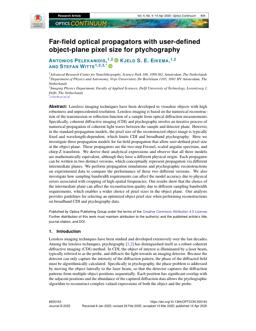2025-04-10
Far-field optical propagators with user-defined object-plane pixel size for ptychography
Publication
Publication
Opt. Continuum , Volume 4 - Issue 4 p. 804- 825
Lensless imaging techniques have been developed to visualize objects with high robustness and unprecedented resolution. Lensless imaging is based on the numerical reconstruction of the transmission or reflection function of a sample from optical diffraction measurements. Specifically, coherent diffractive imaging (CDI) and ptychography involve an iterative process of numerical propagation of coherent light waves between the sample and detector plane. However, in the standard propagation models, the pixel size of the reconstructed object image is typically fixed and wavelength-dependent, which limits CDI and broadband ptychography. Here we investigate three propagation models for far-field propagation that allow user-defined pixel size at the object plane. These propagators are the two-step Fresnel, scaled angular spectrum, and chirp-Z transform. We derive their analytical expressions and observe that all three models are mathematically equivalent, although they have a different physical origin. Each propagator can be written in two distinct versions, which conceptually represent propagation via different intermediate planes. We perform propagation simulations and ptychographic reconstructions on experimental data to compare the performance of these two different versions. We also investigate how sampling bandwidth requirements can affect the model accuracy due to physical errors associated with cropping of high spatial frequencies. Our results show that the choice of the intermediate plane can affect the reconstruction quality due to different sampling bandwidth requirements, which enables a wider choice of pixel sizes in the object plane. Our analysis provides guidelines for selecting an optimized object pixel size when performing reconstructions on broadband CDI and ptychography data.
| Additional Metadata | |
|---|---|
| OPG | |
| ASML, ARCNL, VU, UvA, RUG, NWO | |
| doi.org/10.1364/optcon.555163 | |
| Opt. Continuum | |
| Organisation | EUV Generation & Imaging |
|
Pelekanidis, A., Eikema, K., & Witte, S. (2025). Far-field optical propagators with user-defined object-plane pixel size for ptychography. Opt. Continuum, 4(4), 804–825. doi:10.1364/optcon.555163 |
|

